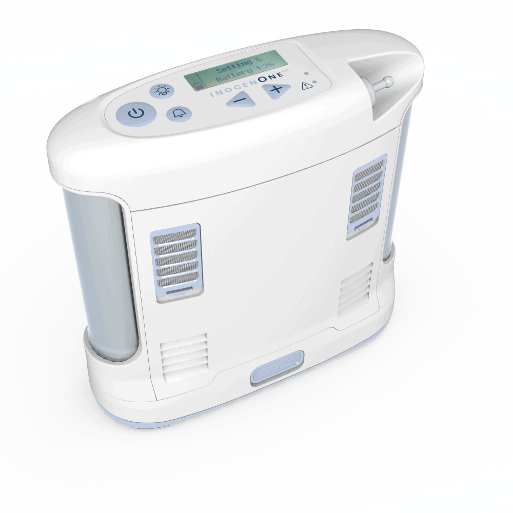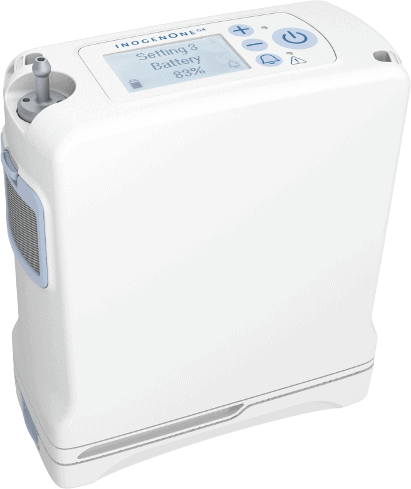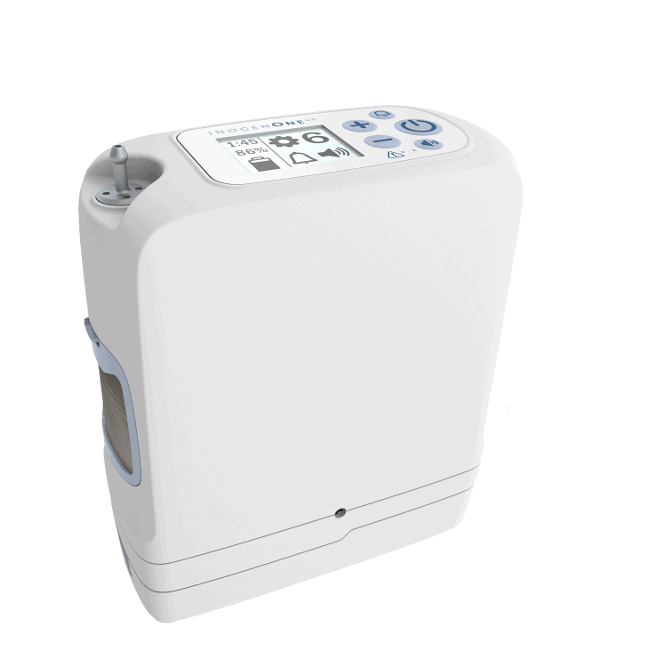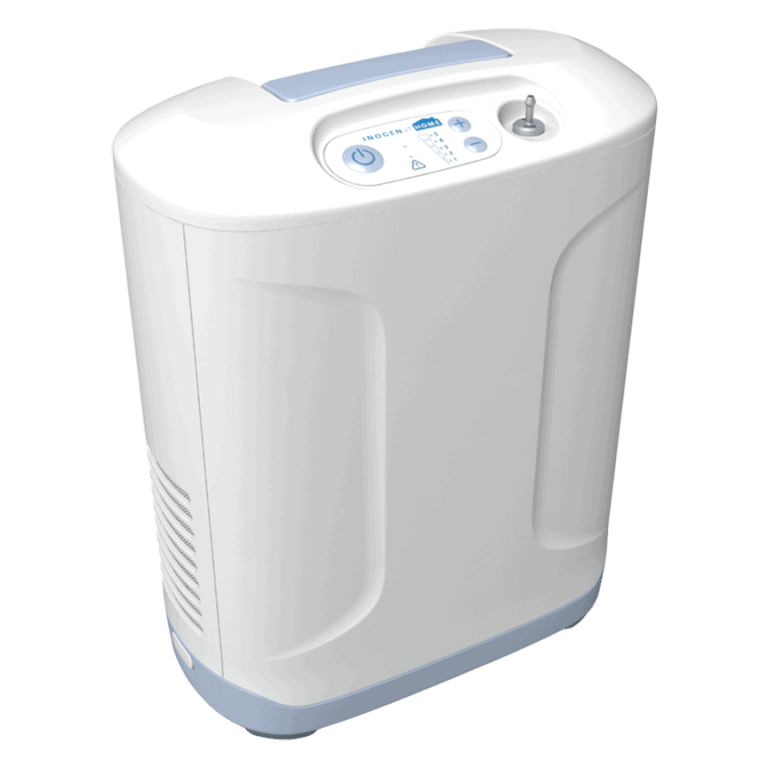
Inogen Portable Oxygen Concentrators: Devices and Pricing

Inogen Oxygen Concentrators: Takeaways
- In our experience, Inogen’s portable oxygen concentrators are among the most lightweight and reliable.
- Inogen’s oxygen concentrators will cost roughly $1,500-$2,600 for the base unit, and supplies like tubing cost extra.
- When prescribed by a doctor, portable oxygen will be covered by Medicare.
Inogen revolutionized older adult respiratory care in 2001 when it introduced the first-ever portable oxygen concentrator that did not require refills. Instead, the machine purified oxygen from its surrounding environment, eliminating the need for bulky oxygen tanks. Twenty years later, Inogen continues to give people who use oxygen therapy the confidence, freedom, and independence of an active lifestyle.
In this rundown, I’ll provide a thorough overview of Inogen, including its systems, how they function, what they cost, and their overall value. Let’s take a closer look.
Pro Tip: New to the world of portable oxygen concentrators? Check out my Portable Oxygen Concentrator Guide to learn about how the technology works and how much it costs.
My Favorite Portable Oxygen Retailer
As an experienced caregiver, I trust the Oxygen Concentrator Store because they offer a wide selection of portable oxygen concentrators, making it easy to find the perfect match for my patients’ needs, and their knowledgeable customer service team is always ready to provide guidance and answer my questions. This combination of expert support and variety ensures I can make the best choices for those in my care, while their competitive pricing and reliable delivery options give me peace of mind. Together, these qualities make them my favorite resource for dependable oxygen solutions.
Inogen Products and Pricing
Inogen offers four oxygen concentrators, three of which are portable. Base unit prices range from about $1,500 to about $2,600, and Inogen provides several package options for each concentrator and its related parts and accessories.
Inogen System Pricing
| Systems | Available through insurance | Maximum oxygen flow time* | Weight | Portable | Energy-saving | Base unit price |
|---|---|---|---|---|---|---|
| Inogen At Home | No | n/a | 18 lbs. | No | Yes | $1,495 |
| Inogen One G3 | Yes | 10 hours | 4.8 lbs. | Yes | No | $2,595 |
| Inogen One G4 | No | 5 hours | 2.8 lbs. | Yes | No | $2,295 |
| Inogen One G5 | No | 13 hours | 4.7 lbs. | Yes | No | $2,395 |
*refers to maximum flow time with double battery
Inogen G3 System
Quiet yet powerful, the G3 system weighs only 4.8 pounds and maintains the same oxygen purity as larger concentrators. It has five flow settings, so it can accommodate changes in conditions over time. The G3 concentrator also meets FAA travel guidelines, which comes in handy if you travel by air frequently. Inogen’s Intelligent Delivery Technology ensures the G3 concentrator provides safe oxygen delivery during rest, exertion, and sleep, and the system is clinically validated for 24/7 use.
Available only through Medicare or insurance, Inogen’s portable G3 system is ideal for use at home or while on the go. Capable of running for up to 10 hours without a recharge, the G3 system, which can also charge via carport, allows for all day independence.

Inogen G4 System
Known for its portability, the G4 is the smallest Inogen system, which makes the FAA-approved device perfect for air travel. Weighing only 2.8 pounds — less than an average toaster — the G4 won’t hold you back or slow you down like heavier tanks.
The G4 base unit, priced at $2,295, matches the purity of larger concentrators and is clinically validated for 24/7 use. Its three flow settings are fewer than its predecessor, though, which limits its accommodation of prescription changes. It’s a trade-off you may be willing to make for such a compact and lightweight system.

The other primary difference between the G4 and its predecessor is that the G4 has a limited charge. Its single battery lasts less than three hours, and its double battery lasts only five hours before needing a charge. That may be fine if you are not always on the go or if you have breaks during your day, but I’d recommend purchasing extra batteries since it sometimes takes several hours to reach a full charge.
The G4 starts to make up for its lack of battery power with the addition of the Inogen Connect app, which helps you monitor battery life, update your system’s software, and access customer support.
Inogen G5 System
Delivering the most oxygen per pound of any concentrator on the market, Inogen’s portable G5 system is priced at $2,395. Its single battery lasts more than six hours, and its double battery can go for up to 13 hours. Compact and weighing less than 5 pounds, this machine fits easily in a tote bag or backpack.
Like all of Inogen’s concentrators, the G5 is clinically validated for 24/7 use. Similar to the G4 system, Inogen G5 comes with access to the Inogen Connect app. To learn more about my experience with this device, check out my Inogen One G5 review.

Inogen at Home
Rather than providing pulses of oxygen like Inogen’s other concentrators, Inogen at Home provides 5 liters of continuous oxygen. The ultra-quiet system is one of the most energy-efficient oxygen concentrators on the market, which can save you up to $300 a year in utility costs.
Most at-home oxygen concentrators weigh about 40 pounds, but Inogen at Home comes in at less than half of that — 18 pounds. It’s designed for stationary use, but many people move their oxygen equipment around their homes. I couldn’t easily move a 40-pound concentrator, but an 18-pound device is much more manageable. With five flow settings, the Inogen at Home system can accommodate changes in your condition, circumstances, or prescription.

Tip: With Inogen, you never have to worry about where your system’s equipment comes from or what credentials its engineers have. All of Inogen’s products are designed and assembled in the United States.
Purchasing From Inogen
You can purchase an Inogen oxygen therapy system on the company’s website or call its sales line. Buying online is faster, but speaking to a customer care agent on the phone is a great way to get expert input and customize your purchase. Given Inogen’s return policy, you’ll probably want to buy everything during one purchase.
As I reviewed Inogen’s website, I was reminded that supplemental oxygen of any kind requires a prescription from a doctor. Make sure you’ve received a prescription and discussed your needs with your medical provider before beginning your search for a portable oxygen concentrator. Once you place your order, you’ll receive a call from an Inogen specialist, who will record your prescription information.
Since they’re considered durable medical equipment, most of Inogen’s portable oxygen concentrators are covered by Medicare.
Inogen Parts and Accessories
A variety of accessories are available to help you carry your Inogen oxygen concentrator with comfort and protection. Inogen also offers replacement items, such as power cords and filters, a la carte. Double batteries can be purchased on their own or as part of a Freedom Package, which is available on the Inogen website.
Inogen Accessories
| System/Accessory | G3 | G4 | G5 | Inogen At Home |
|---|---|---|---|---|
| Cart | $125 | No | $125 | No |
| Carry Strap | No | $13.95 | No | No |
| Carry Bag | $49 | $24.95 | $59 | No |
| External Battery Charger | $285 | $285 | $285 | No |
| Hip Bag | No | $59 | No | No |
| Backpack | $100 | $100 | $100 | No |
| AC Power Supply | $149 | $79 | $149 | No |
| DC Power Cable | $65 | $65 | $65 | No |
| Single Battery | $325 | $325 | $325 | No |
| Double Battery | $495 | $495 | $495 | No |
| Replacement Column | $99 | $99 | $99 | $149 |
| Particle Filters | $19 to $21 | $11.95 | $21 | $27 |
Cart
Specifically tailored to transport your Inogen One G3 or G5, this lightweight cart has two adjustable height levels: 34 inches and 41 inches. The cart fully collapses to less than 18 inches for simple transport or storage. Despite weighing only about 3 pounds, the cart is durable and fares well when rolling over uneven surfaces.
Carry Bag and Strap
Providing a protective cover for your Inogen machine and a convenient handle and shoulder strap, the carry bag is available for both the G3 and G5 systems. The bag also features a small pocket for items such as ID and credit cards.
Backpack
Backpacks are ideal for your oxygen concentrator while you’re on the go. Each lightweight backpack has adjustable straps and a main compartment for your Inogen concentrator, along with spaces for your water bottle, extra batteries, and anything else you may need. The G4 and G5 backpacks include a thermoformed shell that provides extra padding and protection for your concentrator during your daily adventures.
Hip Bag
A first of its kind, the G4 hip bag includes a strong thermoformed belt, which provides stability and comfort without damaging your oxygen concentrator. There are two pockets for carrying a wallet, cell phone, keys, or other personal items. Although the hip bag doesn’t have space for a jacket, I love that I could keep my concentrator at my side without having to wear a large item on my back. If you deal with hip problems, though, this accessory probably isn’t the best choice.
Double Battery
Double batteries enable their systems to run longer, which gives you more time to enjoy life before you need to stop and recharge your concentrator. With the 13 hours a G5 double battery lasts, a double battery is a must. Keep in mind that your flow setting will also affect how long your battery lasts.
Did you know: Taken from the phrase “innovative oxygen,” the name Inogen expresses the company’s approach to product development.
Setting up Your Inogen System
Setup for Inogen concentrators is easy and requires no additional tools or expertise. Inogen provides step-by-step setup videos for each of its systems in the Support section of its website. The following instructions are for the G3 system, but setup for the other concentrators is very similar.
Inogen Setup Process
- When you receive your box in the mail, unpack the contents and lay everything out on your table.
- Read the Getting Started guide and user manual included in your package.
- Remove the concentrator from the carry bag, and ensure both particle filters (mini gray vents at the bottom of the device) are in place.
- Place the concentrator back in the carry bag, and verify you can see both intake (bottom) and exhaust (top) vents through the mesh material of the bag. Don’t zip the bag yet.
- Slide the battery into the bottom of the concentrator until the latch returns to the upper position, and then zip the bag.
- Locate the AC power supply and ensure the input power cord is connected to the power supply.
- Plug the AC power supply into a wall outlet, and connect the other side to the port at the top of your concentrator. This will charge your device. An empty battery may take up to four hours to charge.
- Connect the plastic nasal tubing to the metal port on the concentrator.
- Use the large power button to turn on the machine.
- Change the flow to the setting prescribed by your doctor.
- Put the nasal tubing on your face and breathe normally.
Inogen Returns and Warranties
Inogen offers a 30-day trial period after the purchase of an oxygen therapy system. If you are dissatisfied with your product, you may return it for a refund after you have completed an equipment return form (available on Inogen’s website) and sent back your equipment. You can also complete most of your return information over the phone.
Inogen will charge you a $99 handling fee if you choose to return your system, which seems rather steep. Due to Inogen’s detailed reprocessing system, it may take up to 10 business days after your product reaches the company to receive your refund. Unlike Inogen systems, accessories and parts are not eligible for return unless they were purchased and returned with an eligible Inogen One system.
Inogen Warranties
All Inogen machines include a three-year warranty. If you purchase one of the company’s Freedom Packages, it becomes a lifetime warranty. These nontransferable warranties guarantee that, within the agreed period of coverage, your product is warranted to be free of defects “in materials and workmanship under normal use and service.”
Recap
Inogen’s portable oxygen concentrators allow oxygen therapy patients to enjoy active and on-the-go lifestyles that were, until recent years, impeded by their need for constant oxygen and heavy refill tanks they had to lug around.
I’m more of a discount kind of gal, and, unless you have Medicare or insurance to cover your oxygen therapy, Inogen’s systems and accessories cost a pretty penny. I like that Inogen’s systems provide freedom once thought to be impossible for patients on supplemental oxygen. Inogen may not be the financially smart answer for oxygen therapy if you rarely leave your home, but if you want to keep living life to its fullest inside, outside, and around your home, the company’s portable oxygen concentrators are a solid solution.
Frequently Asked Questions
-
Are Inogen portable oxygen concentrators safe for commercial air flight?
The Inogen One meets FAA guidelines for use onboard any commercial aircraft starting or stopping in the United States. Many international airlines also allow FAA-compliant portable oxygen concentrators. It’s important to check with each airline and country you fly within for their specific policies and procedures.
-
How will my Inogen machine react to hot or cold environments?
When using your Inogen machine, it’s wise to stay inside if outdoor temperatures are higher than 90 degrees or below freezing. In hot weather, your system can overheat and damage its batteries. Cold, snowy environments can potentially harm your device since they’re not waterproof.
-
Can I smoke around or while using my Inogen One machine?
Do not smoke or let someone within 10 to 15 feet of you smoke while using your Inogen oxygen concentrator. If your concentrator catches a spark, it could start a serious fire.
-
How do I maintain my Inogen oxygen concentrator?
Your oxygen concentrator requires regular maintenance in a variety of areas, including batteries, nasal mask, case, and particle filters. For specific instructions, refer to your user manual.
-
How long do Inogen One batteries last?
Inogen One batteries have a wide range of lifespans, from as little as 2.7 hours for a single battery on the G4 system to as long as 13 hours using a double battery on the G5 system.

